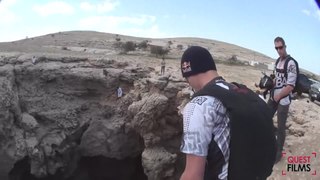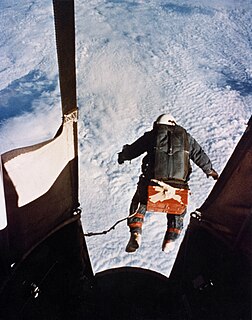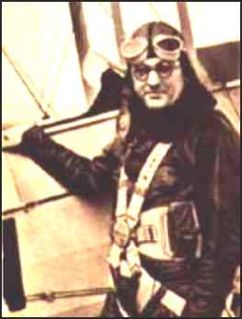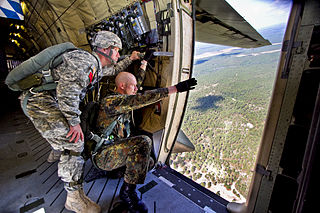Related Research Articles

BASE jumping is the recreational sport of jumping from fixed objects, using a parachute to descend safely to the ground. "BASE" is an acronym that stands for four categories of fixed objects from which one can jump: building, antenna, span, and earth (cliff). Participants exit from a fixed object such as a cliff, and after an optional freefall delay, deploy a parachute to slow their descent and land. A popular form of BASE jumping is wingsuit BASE jumping.

A parachute is a device used to slow the motion of an object through an atmosphere by creating drag. Parachutes are usually made out of light, strong fabric, originally silk, now most commonly nylon. They are typically dome-shaped, but vary, with rectangles, inverted domes, and others found. A variety of loads are attached to parachutes, including people, food, equipment, space capsules, and bombs.

Wingsuit flying is the sport of flying through the air using a wingsuit which adds surface area to the human body to enable a significant increase in lift. The modern wingsuit, first developed in the late 1990s, creates a surface area with fabric between the legs and under the arms. Wingsuits are sometimes referred to as "birdman suits", "squirrel suits", and "bat suits".

Project Excelsior was a series of parachute jumps made by Joseph Kittinger of the United States Air Force in 1959 and 1960 from helium balloons in the stratosphere. The purpose was to test the Beaupre multi-stage parachute system intended to be used by pilots ejecting from high altitude. In one of these jumps Kittinger set world records for the longest parachute drogue fall, the highest parachute jump, and the fastest speed by a human through the atmosphere. He held the latter two of these records for 52 years, until they were broken by Felix Baumgartner of the Red Bull Stratos project in 2012, though he still holds the world record for longest time in free fall.

A parachutist badge is a military badge awarded by the armed forces of many states to soldiers who receive the proper parachute training and accomplish the required number of jumps. It is difficult to assess which country was the first to introduce such an award.

The Military Freefall Parachutist Badge is a military badge of the United States Army and United States Air Force awarded to qualified U.S. Army and U.S. Air Force personnel as high-altitude military parachute specialists.

The Parachutist Badge, also commonly referred to as "Jump Wings" is a military badge of the United States Armed Forces. The United States Space Force and United States Coast Guard are the only branches that do not award the Parachutist Badge, but their members are authorized to receive the Parachutist Badges of other services in accordance with their prescribed requirements. The DoD military services are all awarded the same Basic Parachutist Badge. The U.S. Army and U.S. Air Force issue the same Senior and Master Parachutist Badges while the U.S. Navy and U.S. Marine Corps issue the Navy and Marine Corps Parachutist Badge to advanced parachutists. The majority of the services earn their Basic Parachutist Badge through the U.S. Army Airborne School.

The United States Army Airborne School – widely known as Jump School – conducts the basic paratrooper training for the United States armed forces. It is operated by the 1st Battalion (Airborne), 507th Infantry, United States Army Infantry School, Fort Benning, Georgia. The Airborne School conducts the Basic Airborne Course, which is open to troops of both genders from all branches of the United States Department of Defense, Reserve Officer Training Corps, and allied military personnel. All students must volunteer to attend the course.

A static line is a fixed cord attached to a large, stable object. It is used to open parachutes automatically for paratroopers and novice parachutists.

A pilot chute is a small auxiliary parachute used to deploy the main or reserve parachute. The pilot chute is connected to the deployment bag containing the parachute by a bridle. Pilot chutes are a critical component of all modern skydiving and BASE jumping gear. Pilot chutes are also used as a component of spacecraft such as NASA's Orion.

Tandem skydiving or tandem parachuting refers to a type of skydiving where a student skydiver is connected to an instructor via a harness. The instructor guides the student through the whole jump from exit through freefall, piloting the canopy, and landing. The student needs only minimal instruction before making a tandem jump with the instructor. In the United States most skydiving centers and clubs require that you be 18 years or older to skydive whereas in other countries the minimum age can be lower or higher. This is one of three commonly used training methods for beginning skydivers; the others being Static line, Instructor-assisted deployment (IAD), and Accelerated freefall (AFF) (k).

Accelerated freefall (AFF) is a method of skydiving training. This method of skydiving training is called "accelerated" because the progression is the fastest way to experience solo freefall, normally from 10,000 to 15,000 feet above ground level (AGL). In static line progression, more jumps are required to experience freefall, but the jumps are less expensive for the student as one instructor can dispatch multiple students per load and students are initially dispatched from lower altitudes. Under accelerated freefall, one or sometimes two instructors are dedicated just to one student.

Leslie Leroy Irvin was a stunt-man for the fledgling Californian film industry. Flying in balloons, he performed using trapeze acrobatics and parachute descents. For the 1914 film Sky High, Irvin made his first jump out of an airplane while flying at 1,000 feet above the ground. In 1918, he developed his own life-saving static line parachute, jumping with it several times and promoting it to the US Army. Irvin joined the Army Air Service's parachute research team at McCook Field near Dayton, Ohio where he made the first premeditated free-fall jump with the modern parachute on 28 April 1919.

The United States Army Parachute Team, nicknamed the Golden Knights, is a demonstration and competition parachute team of the United States Army. It consists of demonstration and competition parachutist teams, drawn from all branches of the U.S. Army. Members must demonstrate excellence in parachuting.
British Parachute Schools also known as Langar DZ or Skydive Langar is a BPA affiliated parachuting centre and skydiving drop zone at Langar, Nottinghamshire in the area known as the Vale of Belvoir.

Jumpmasters are the expert paratroopers in an airborne unit who train and teach the military techniques for jumping from airplanes. They are responsible for training soldiers who enter Army Airborne School into paratroopers and managing airborne jump operations in airborne units across all branches of services.

Parachuting is a method of transiting from a high point to Earth with the aid of gravity, involving the control of speed during the descent using a parachute or parachutes. It may involve more or less free-falling which is a period when the parachute has not yet been deployed and the body gradually accelerates to terminal velocity.

The RA-1 Military Free-Fall Advanced Ram-Air Parachute System provides a multi-mission, high-altitude parachute delivery system that allows personnel to exit at altitudes between 3,500 feet and 35,000 feet. The parachute, which replaces the current MC-4 parachute, supports a total jumper weight of 450 pounds. It also provides non-MFF personnel with a ram-air parachute that is static-line deployed.
Red Bull Stratos was a high altitude skydiving project involving Austrian skydiver Felix Baumgartner. On 14 October 2012, Baumgartner flew approximately 39 kilometres (24 mi) into the stratosphere over New Mexico, United States, in a helium balloon before free falling in a pressure suit and then parachuting to Earth. The total jump, from leaving the capsule to landing on the ground, lasted approximately ten minutes. While the free fall was initially expected to last between five and six minutes, Baumgartner deployed his parachute after 4 minutes and 19 seconds.
CharlesBroadwick was an American pioneering parachutist and inventor. Speaking about Broadwick, an executive director of the U.S. Parachute Association, Ed Scott, said "just about all modern parachute systems" use ideas Broadwick developed: "an integrated, form-fitting harness and container system nestled on the back." Broadwick also developed the static line, a line from a parachute to an aircraft that pulls the parachute from its pouch. Static lines are still used today, for instance by paratroopers and novice skydivers. U.S. Army Warrant Officer Jeremiah Jones commented, "[Broadwick] is like the grandfather of paratroopers." In addition, Broadwick demonstrated parachute jumps at fairs and taught and equipped famous female parachutist Tiny Broadwick.
References
- ↑ The British Parachute Association Archived 2007-01-10 at the Wayback Machine